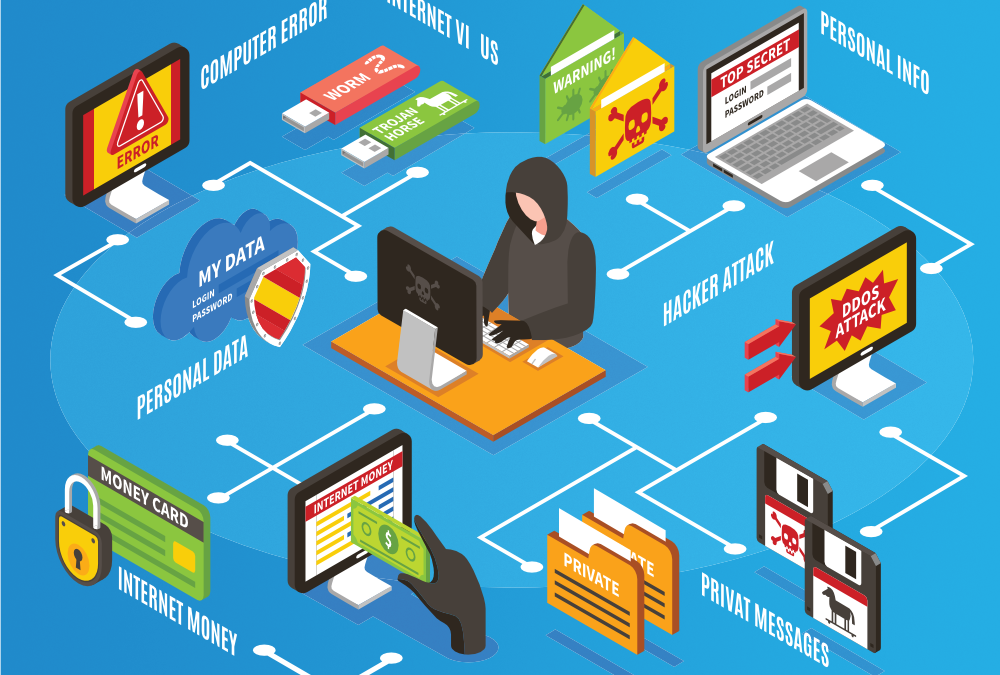Cybersecurity is the practice of preventing unauthorized access, theft, damage, or any other type of cyber attack. With an ever-increasing reliance on technology and the internet, cybersecurity has emerged as a crucial worry for consumers, corporations, and governments all over the world.
Phishing scams, malware, ransomware, and social engineering are all examples of cyber attacks. These assaults have the potential to steal sensitive information such as financial information, personal information, trade secrets, and government secrets. Individuals, organizations, and even entire countries can suffer severe financial and reputational harm as a result of cyber assaults.
Table of Contents
What are the many kinds of cybersecurity threats?
It is difficult to keep up with new technology, security trends, and threat intelligence. It is required to protect information and other assets against cyber threats, which come in a variety of forms. The following are examples of cyber threats:
- Malware is a type of harmful software that can use any file or program to harm a computer user. Worms, viruses, Trojans, and spyware are all examples of malware.
- Another sort of malware is ransomware, which involves an attacker encrypting and locking the victim’s computer system files and demanding payment to decrypt and unlock them.
- Social engineering is a type of attack that involves human involvement. It dupes users into violating security protocols to obtain sensitive information.
- Phishing is a type of social engineering in which fake email or text messages are delivered that appear to be from legitimate or well-known sources. The objective of these messages, which are frequently random attacks, is to steal sensitive data, such as credit card or login information.
- Spear phishing is a sort of phishing that targets a specific user, organization, or business.
- Insider risks are defined as security breaches or losses caused by humans, such as workers, contractors, or customers. Insider dangers can be malicious or careless.
- DDoS assaults are ones in which several systems disrupt the traffic of a single system, such as a server, website, or other network resource. Attackers can slow the target down by flooding it with messages, connection requests, or packets and preventing legitimate traffic from using it.
To defend against cyber attacks, it is critical to understand technology’s risks and weaknesses and to establish a comprehensive cybersecurity strategy. Following are some best practices for effective cybersecurity:
Make use of secure passwords and two-factor authentication
Using strong passwords and multi-factor authentication is one of the simplest and most effective ways to protect sensitive information. A good password should be at least 12 characters long and contain a mix of upper and lower case letters, numbers, and special characters. By requiring a second form of verification, such as a fingerprint or a code delivered to your phone, multi-factor authentication adds an extra layer of protection.
Maintain software updates
Hackers frequently target obsolete software with known flaws. Maintaining software with the most recent security patches and updates can help protect against these types of assaults.
Install firewalls and antivirus software
Any cybersecurity strategy must include firewalls and antivirus software. A firewall is a network security device that monitors and restricts network traffic based on predefined security rules. Antivirus software detects and eliminates viruses from computers and networks.
Employees should be educated on cybersecurity best practices
Human mistake is one of the most serious flaws in any cybersecurity plan. Employees must be trained on cybersecurity best practices such as identifying phishing scams, creating secure passwords, and reporting unusual behavior.
Back up your files regularly
Backing up data regularly is a vital component of any cybersecurity plan. In the event of a cyber-attack, having a backup can aid in the recovery of lost data and reduce the severity of the attack.
Encrypt your data
The practice of transforming sensitive information into code to prevent unauthorized access is known as encryption. Encryption can be used to safeguard data in transit as well as at rest.
Perform regular security audits
Regular security audits can assist in identifying flaws in your cybersecurity strategy and ensuring that all systems are current and secure. Internal or third-party security audits might be performed.
Create an incident response plan
Cyber assaults may still occur despite the greatest attempts. Creating an incident response plan can assist to reduce the effects of an attack while also ensuring a timely and effective response.
Restriction of access to sensitive information
Access to sensitive information must be restricted as part of any cybersecurity policy. Access to sensitive data should be restricted to authorized individuals only, and access should be terminated immediately when no longer required.
Monitor activity and put threat detection tools in place
Monitoring activity and putting threat detection systems in place can aid in the detection of unusual activity and potential cyber-attacks. Threat detection technologies can be used to monitor network activity, detect and respond to threats in real-time, and discover vulnerabilities.
Finally, securing sensitive information from cyber threats is a top priority for individuals, corporations, and governments. Using strong passwords, keeping software up to date, implementing firewalls and antivirus software, training employees on cybersecurity best practices, regularly backing up data, using encryption, conducting regular security audits, developing an incident response plan, limiting access to sensitive information, and monitoring activity can all help to protect against cyber attacks. Individuals and organizations can lower the risk of cyber assaults by taking these precautions.



